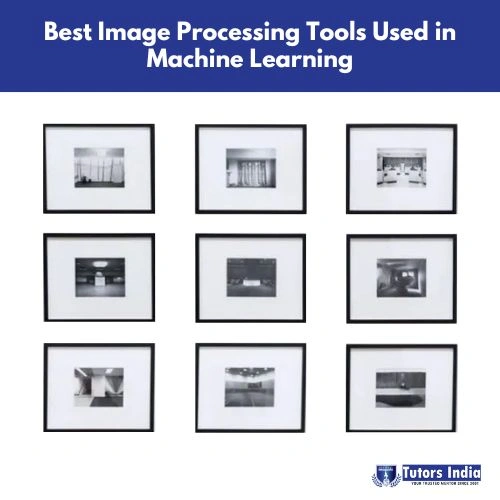TOP 13 IMAGE PROCESSING TOOLS TO EXPECT IN 2023
Introduction
As the name suggests, processing an image entails a number of steps before we reach our goal. The end result may be an image or a feature that is similar to that image. Additional research and decision-making can be done using this information. Below are the best image processing tools used in machine learning.

Figure1: Best image Processing Tools Used in Machine Learning
OpenCV
A popular library that is simple to use is multi-platform. It flawlessly integrates with C++ and Python and provides all the essential methods and algorithms needed to complete a few image and video processing tasks (Salvi et al., 2021).
Matlab
Since it allows for rapid prototyping, Matlab is a great tool for creating image processing systems and is extensively used in research. Another interesting point is how much shorter Matlab code is than C++ code, making it simpler to read and troubleshoot. It addresses errors prior to execution by offering a number of options to expedite the process.
CUDA
NVIDIA, which is fast, highly efficient, and easy to program, serves as the foundation for parallel computing. It gives outstanding performance by utilizing GPU power. Incorporated into its toolset is the NVIDIA Performance Primitives library, which offers a variety of image, signal, and video processing techniques (Abdulrahman et al., 2021).
Tensorflow
The most used deep learning and machine learning library currently in use is this one. It quickly gained popularity and surpassed competing libraries due to the ease of use of the API. The differential programming and data stream library TensorFlow is open-source and free. It is a symbolic math library that is utilized by neural networks and other machine learning applications.
TensorFlow 2.0 encourages the use of pre-built models for a variety of applications, including object detection, reinforcement learning, voice and picture recognition. These reference models give you the ability to employ certain best business practices and act as a platform for creating your superior solutions (Reinke et al., 2021).
SimpleCV
A system for creating computer vision applications is called SimpleCV. It provides access to several computer vision technologies on any OpenCV, pygame, and other platforms. You need this program if all you need to do is finish the task and you don’t want to learn all the specifics of image processing. SimpleCV is the best option if rapid prototyping is required.
PyTorch
Machine learning open-source platform PyTorch. The process is designed to accelerate the transition from a research prototype to commercial development.
- Easy production transition
- Performance enhancement with distributed adaptive learning
- Thriving ecosystem for tools and libraries
- Excellent support for the primary cloud platforms
- Optimization modules and independent differentiation
Keras
Tensorflow, Theano, and CNTK are just a few of the libraries that Keras, a deep learning Python library, includes. In comparison to competitors like Scikit-learn and PyTorch, Keras has an advantage because it is developed on top of Tensorflow.
Any of the following can be utilized with Keras: TensorFlow, Microsoft Cognitive Toolkit, Theano, or PlaidML. It is made for quick deep neural network experimentation and places a premium on convenience, quantitative quality, and extensibility. Keras adheres to best practices for decreasing cognitive load by offering stable and basic APIs and limiting the amount of user involvement required for typical use cases (Zhang, 2021).
Theano
Theano is a swift Python numerical library that may be utilized with a CPU or GPU. At the Canadian University of Montreal, it was created by the LISA group, which is now known as MILA. Theano is a developing compiler for controlling and assessing mathematical expressions, particularly those using matrix values.
EmguCV
EmguCV is a platform-agnostic image processing program. a Net extension for OpenCV. IronPython, C#, VB, and VC++ are among the.NET compatible languages that it supports. It runs on Windows, Linux, Mac OS, iOS, and Android platforms. It is also compatible with Visual Studio, Xamarin Studio, and Unity.
GPUImage
It is an OpenGL ES 2.0-based framework that enables the addition of GPU-accelerated effects and channels to the live-act video side, still images, and motion pictures. To set up and keep running custom channels on a GPU, a significant amount of code must be developed.
YOLO
“You Just Look Once” (YOLO), an approach to object detection, was created with real-time processing in mind. Joseph Redmon and Ali Farhadi, researchers at the University of Washington, created the advanced real-time object detection technology known as YOLO. Their method uses a neural network to divide the entire image into districts with the found items, leaving imprints of those districts on the grid (Ding et al., 2021).
VXL
VXL is a collection of open-source C++ libraries. This image editing application has the ability to open, save, and edit photos in a variety of frequently used file types, including huge images. Geometry for points, curves, and other fundamental objects in 1, 2, or 3 dimensions.
- Camera physics
- regaining stability following movement
- Implementing a graphical user interface
- 3D topology pictures
BoofCV
BoofCV is an open-source Java framework with an Apache 2.0 license that may be used for both professional and academic real-time robotics and computer vision applications. Structure-from-motion, feature tracking, camera alignment, and efficient low-level image processing techniques are some of its features (C et al., 2022).
Conclusion
Deep learning’s use of Broadway lingo and advances in image processing are changing the world. This is just the beginning of the learning process because scientists are constantly creating better techniques to optimize the entire field of image processing. All the tasks you must accomplish can be completed using a variety of image processing techniques.
Looking to write a research proposal on image processing techniques? At tutorsindia, Our expertise will assist you from identifying problem to the research solutions
Reference
- Abdulrahman, A.A., Rasheed, M. & Shihab, S. (2021). The Analytic of Image Processing Smoothing Spaces Using Wavelet. Journal of Physics: Conference Series. [Online]. 1879 (2). pp. 022118. Available from:
- C, D., N, N.U., Maddikunta, P.K.R., Gadekallu, T.R., Iwendi, C., Wei, C. & Xin, Q. (2022). Identification of malnutrition and prediction of BMI from facial images using real‐time image processing and machine learning. IET Image Processing. [Online]. 16 (3). pp. 647–658.
- Ding, K., Ma, K., Wang, S. & Simoncelli, E.P. (2021). Comparison of full-reference image quality models for optimization of image processing systems. International Journal of Computer Vision. [Online]. 129 (4). pp. 1258–1281. Available from:
- Reinke, A., Tizabi, M.D., Sudre, C.H., Eisenmann, M., Radsch, T., Baumgartner, M., Acion, L., Antonelli, M., Arbel, T. & Bakas, S. (2021). Common limitations of image processing metrics: A picture story. arXiv preprint arXiv:2104.05642. [Online]. Available from:
- Salvi, M., Acharya, U.R., Molinari, F. & Meiburger, K.M. (2021). The impact of pre- and post-image processing techniques on deep learning frameworks: A comprehensive review for digital pathology image analysis. Computers in Biology and Medicine. [Online]. 128. pp. 104129. Available from:
- Zhang, Y.-J. (2021). Image Engineering. In: Handbook of Image Engineering. [Online]. Singapore: Springer Singapore, pp. 55–83. Available from:

 Previous Post
Previous Post Next Post
Next Post